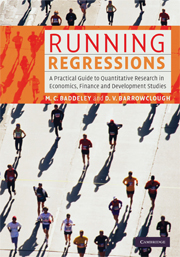 Running Regressions
Running Regressions Book contents
- Frontmatter
- Contents
- List of figures
- List of tables
- List of boxes
- Acknowledgements
- List of acronyms
- How to use this book
- Part I Simple regression and data analysis
- Part II Multiple regression and diagnostic testing
- Part III Time-series econometrics
- 9 Structural breaks, non-stationarity and spurious regressions
- 10 Error correction models
- Part IV Advanced topics
- Index
- References
9 - Structural breaks, non-stationarity and spurious regressions
Venture capital and computing investment in the USA
Published online by Cambridge University Press: 05 June 2014
- Frontmatter
- Contents
- List of figures
- List of tables
- List of boxes
- Acknowledgements
- List of acronyms
- How to use this book
- Part I Simple regression and data analysis
- Part II Multiple regression and diagnostic testing
- Part III Time-series econometrics
- 9 Structural breaks, non-stationarity and spurious regressions
- 10 Error correction models
- Part IV Advanced topics
- Index
- References
Summary
Economic issues include:
The New Economy
Investment in computing
Venture capital funding
Econometric issues include:
Structural breaks
Unit roots, non-stationarity and spurious regressions
Data issues include:
Measuring the New Economy
The issue
In this chapter we will look at the relationship between computing investment and venture capital financing in the New Economy. Computing investment has been essential to the growth of the New Economy: Yang and Brynjolfsson (2001) argue that computerisation is the most pervasive technological change this era. IT (information technology) investments promoted improved macroeconomic performance, culminating from large increases in productivity and growth in the 1990s onwards, particularly in the US. Increasing GDP growth was accompanied by reduced volatility in GDP. This is because IT innovations played a key role in promoting greater flexibility; for example, innovations such as price comparison sites (e.g. dealtime.com and kelkoo.com) increased micro-economic flexibility via increased price transparency.
The New Economy grew rapidly from the 1990s onwards and its growth was enabled by venture capital injections. Venture capital is of particular importance because young entrepreneurs are responsible for a substantial proportion of the innovative New Economy investments. These entrepreneurs do not have profits retained from existing production. So venture capital funds are important in providing them finance for their new investments.
In this chapter we will explore the relationship between New Economy investment and venture capital funding.
- Type
- Chapter
- Information
- Running RegressionsA Practical Guide to Quantitative Research in Economics, Finance and Development Studies, pp. 201 - 224Publisher: Cambridge University PressPrint publication year: 2009


